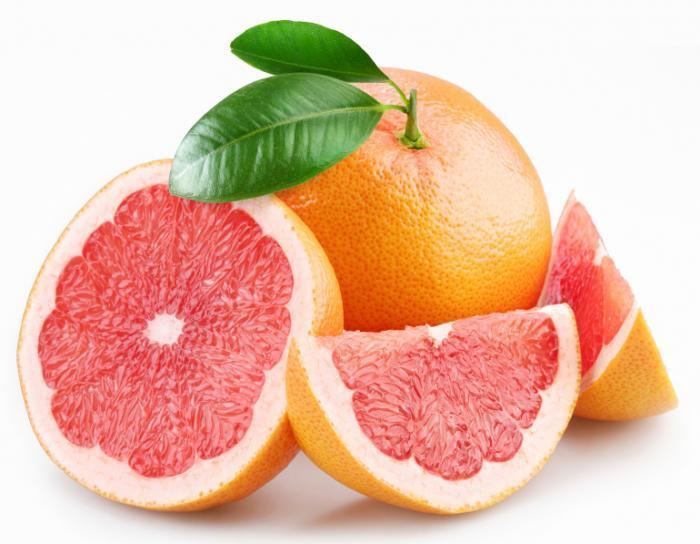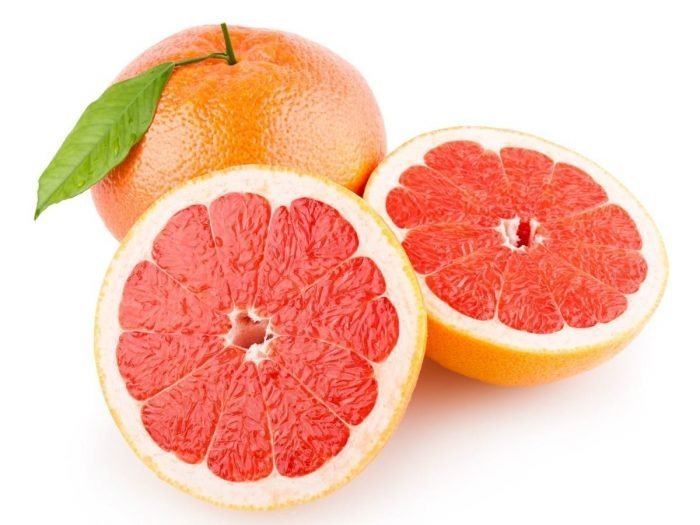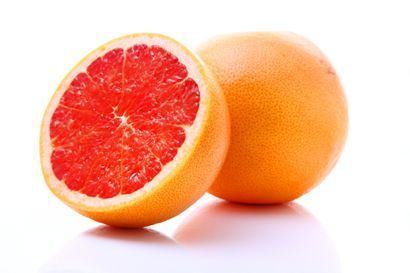Species C. × paradisi | ||
 | ||
Similar Pomelo, Fruit, Orange, Tangerine, Lemon | ||
The grapefruit (Citrus × paradisi) is a subtropical citrus tree known for its sour to semi-sweet fruit. Grapefruit is a hybrid originating in Barbados as an accidental cross between two introduced species, sweet orange (C. sinensis) and pomelo or shaddock (C. maxima), both of which were introduced from Asia in the seventeenth century. When found, it was named the “forbidden fruit”; and it has also been misidentified with the pomelo.
Contents
- Fruit vs zombies grapefruit
- Description
- History
- Ruby Red
- Star Ruby
- Varieties
- Production
- Colors and flavors
- Drug interactions
- Nutritional properties
- Grapefruit sweets
- Other uses
- Grapefruit relatives
- References

The grapefruit's name alludes to clusters of the fruit on the tree, which often appear similar to grapes.
Fruit vs zombies grapefruit
Description

The evergreen grapefruit trees usually grow to around 5–6 meters (16–20 ft) tall, although they can reach 13–15 m (43–49 ft). The leaves are glossy dark green, long (up to 15 centimeters (5.9 in)) and thin. It produces 5 cm (2 in) white four-petaled flowers. The fruit is yellow-orange skinned and generally an oblate spheroid in shape; it ranges in diameter from 10–15 cm (3.9–5.9 in). The flesh is segmented and acidic, varying in color depending on the cultivars, which include white, pink and red pulps of varying sweetness (generally, the redder varieties are sweeter). The 1929 US Ruby Red (of the Redblush variety) has the first grapefruit patent.
History

One ancestor of the grapefruit was the Jamaican sweet orange (Citrus sinensis), itself an ancient hybrid of Asian origin; the other was the Indonesian pomelo (C. maxima). One story of the fruit's origins is that a certain "Captain Shaddock" brought pomelo seeds to Jamaica and bred the first fruit. However, it probably originated as a naturally occurring hybrid between the two plants some time after they had been introduced.

The hybrid fruit, then called "the forbidden fruit", was first documented in 1750 by a Welshman, Rev. Griffith Hughes, who described specimens from Barbados in The Natural History of Barbados. Currently, the grapefruit is said to be one of the "Seven Wonders of Barbados".
The grapefruit was brought to Florida by Count Odet Philippe in 1823 in what is now known as Safety Harbor. Further crosses have produced the tangelo (1905), the Minneola tangelo (1931), and the oroblanco (1984).
The grapefruit was known as the shaddock or shattuck until the 19th century. Its current name alludes to clusters of the fruit on the tree, which often appear similar to grapes. Botanically, it was not distinguished from the pomelo until the 1830s, when it was given the name Citrus paradisi. Its true origins were not determined until the 1940s. This led to the official name being altered to Citrus × paradisi, the "×" identifying its hybrid origin.
An early pioneer in the American citrus industry was Kimball Chase Atwood, a wealthy entrepreneur who founded the Atwood Grapefruit Co. in the late 19th century. The Atwood Grove became the largest grapefruit grove in the world, with a yearly output of 80,000 boxes of fruit. It was there that pink grapefruit was first discovered in 1906.
Ruby Red
The 1929 Ruby Red patent was associated with real commercial success, which came after the discovery of a red grapefruit growing on a pink variety. The Red grapefruit, starting with the Ruby Red, has even become a symbolic fruit of Texas, where white “inferior” grapefruit were eliminated and only red grapefruit were grown for decades. Using radiation to trigger mutations, new varieties were developed to retain the red tones which typically faded to pink. The Rio Red variety is the current (2007) Texas grapefruit with registered trademarks Rio Star and Ruby-Sweet, also sometimes promoted as "Reddest" and "Texas Choice". The Rio Red is a mutation bred variety which was developed by treatment of bud sticks with thermal neutrons. Its improved attributes of mutant variety are fruit and juice color, deeper red, and wide adaptation.
Star Ruby
The Star Ruby is the darkest of the red varieties. Developed from an irradiated Hudson grapefruit, it has found limited commercial success because it is more difficult to grow than other varieties.
Varieties
The varieties of Texas and Florida grapefruit include: Oro Blanco, Ruby Red, Pink, Thompson, White Marsh, Flame, Star Ruby, Duncan, and Pummelo HB.
Production
China is the top producer of grapefruit and pomelo followed by The United States and Mexico.
Colors and flavors
Grapefruit comes in many varieties. One way to differentiate between varieties is by the flesh color of fruit they produce. The most popular varieties cultivated today are red, white, and pink hues, referring to the internal pulp color of the fruit. The family of flavors range from highly acidic and somewhat sour to sweet and tart. Grapefruit mercaptan, a sulfur-containing terpene, is one of the substances which has a strong influence on the taste and odor of grapefruit, compared with other citrus fruits.
Drug interactions
Grapefruit and grapefruit juice have been found to interact with numerous drugs in many cases resulting in adverse effects.
This happens in two ways. One is that grapefruit can block an enzyme which metabolizes medication. If the drug is not metabolized, then the level of the drug in the blood can become too high leading to an adverse effect. The other effect is that grapefruit can block the absorption of drugs in the intestine. If the drug is not absorbed, then not enough of it is in the blood to have a therapeutic effect.
One whole grapefruit, or a glass of 200 mL (6.8 US fl oz) of grapefruit juice can cause drug overdose toxicity. Drugs which are incompatible with grapefruit are typically labeled on the container or package insert. People taking drugs can ask their health care provider or pharmacist questions about grapefruit / drug interactions.
Nutritional properties
Grapefruit is a rich source (>20% of the Daily Value, DV in a 100 gram serving) of vitamin C, contains the fiber pectin, and the pink and red hues contain the beneficial antioxidant lycopene. Studies have shown grapefruit helps lower cholesterol, and there is evidence that the seeds have antioxidant properties. Grapefruit forms a core part of the "grapefruit diet", the theory being that the fruit's low glycemic index is able to help the body's metabolism burn fat.
Although grapefruit seed extract (GSE) is promoted as a plant-based preservative by some natural personal care manufacturers, studies have shown that the apparent antimicrobial activity associated with GSE preparations is merely due to contamination with synthetic preservatives such as parabens.
There is a popular myth that grapefruits contain high amounts of spermidine, a simple polyamine that may be related to aging. The myth probably relies on the confusion between spermidine and putrescine. While citrus fruits show high amounts of putrescine, they contain very little spermidine.
Grapefruit sweets
In Costa Rica, especially in Atenas, grapefruit are often cooked to remove their sourness, rendering them as sweets; they are also stuffed with dulce de leche, resulting in a dessert called toronja rellena (stuffed grapefruit). In Haiti, grapefruit is used primarily for its juice (jus de Chadèque), but is also used to make jam (confiture de Chadèque).
Other uses
Grapefruit has also been investigated in cancer medicine pharmacodynamics. Its inhibiting effect on the metabolism of some drugs may allow smaller doses to be used, which can help to reduce costs.
Grapefruit relatives
Grapefruit is a pummelo backcross, a hybrid of pummelo × sweet orange, with sweet orange itself being a pummelo × mandarin hybrid.
The grapefruit is itself a parent to many hybrids:
The grapefruit's cousins include:
